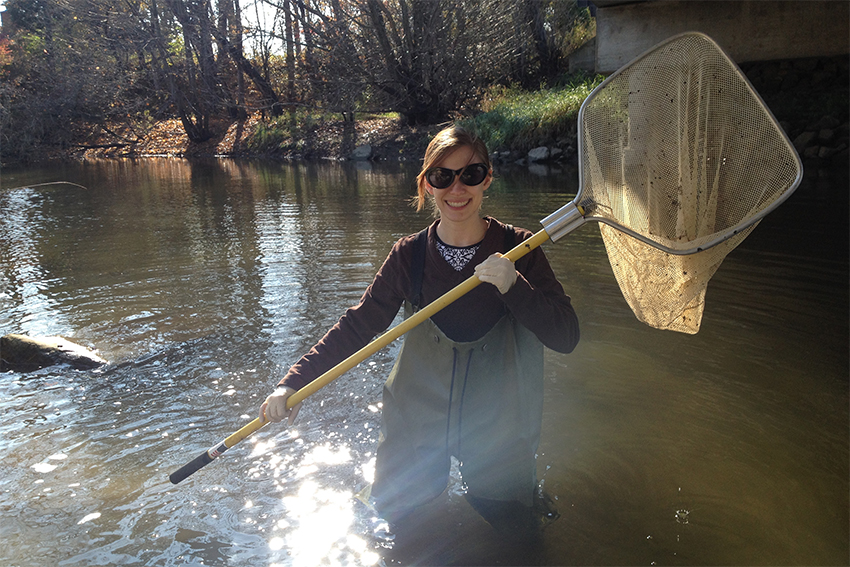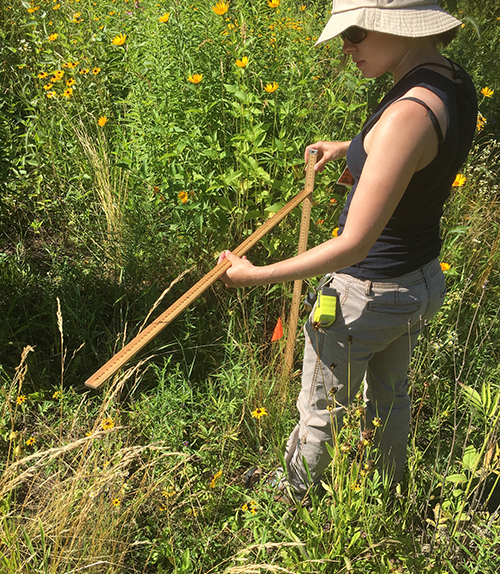Maran to bring science, communication skills to Knauss marine policy fellowship

By Bonnie Blankinship
In January, Bowling Green State University Ph.D. student Audrey Maran, her husband, their cat and two dogs will decamp for Silver Spring, Maryland, where she will serve for a year as a communication specialist in the National Sea Grant office, a division of the National Oceanic and Atmospheric Administration.
Maran, who is finishing her doctorate in biology, was chosen for the John A. Knauss Marine Policy Fellowship, one of the most competitive marine policy fellowships in the United States. She is only the second BGSU student to ever receive the award, and the first in many years.
She will be part of the fellowship’s executive branch; there is also a legislative branch, whose fellows work primarily on Capitol Hill with lawmakers. The 66 finalists represented 30 of the 33 National Sea Grant programs. Since 1979, Sea Grant has provided one-year Knauss fellowships for more than 1,200 early career professionals to work in federal government offices around Washington, D.C.
“This is one of the most prestigious awards that a junior scientist in environmental sciences can be awarded,” said Dr. Shannon Pelini, Maran’s thesis adviser and an associate professor of biological sciences.
“It’s meant for people with a science background, but it gives you a window into how policy works and how science is turned into policy and how policy affects science on the ground. The idea is it’s science to policy,” Maran said. “I have very little background in policy but I’m very interested in it because I firmly believe we need science-based policy in our government, and I want to see if I can play a role in helping make our policy more science-based.”
Brooke Carney, communications lead for Sea Grant and leader of the NOAA Facilitation Network, will be Maran’s mentor at Sea Grant and will work with her to help her reach her goals. For example, Maran said, “I’m really interested in evaluation of the effectiveness of science communication. I’m excited about exploring that.”
Sea Grant is a federal-university partnership program, with a network of university-based researchers and outreach specialists located within the coastal communities they serve. The communication specialists’ job is to communicate effectively with a variety of audiences, from the public to the legislative, about issues and research and their application to both policy and everyday life.
In her new position, which begins Feb. 2, Maran will have a diverse array of assignments on a wide range of subject matter. As part of her information gathering and disseminating, she may be called upon to interview Sea Grant researchers. She will use her science background to explain complex material and messages through stories and visual aids, from video to infographics to social media. She will also be talking with the people doing the field work about how their applications of science are helping the community, as well as sharing information with them.
“Sometimes we’ll get requests from congressmen asking for information and background on topics. In this position, I will do a little bit of that,” she said.
According to Sea Grant, “the 2019 fellowship will include specific projects on communicating research impacts as well as a focus on communicating aquaculture research and collaborating with aquaculture operations in other NOAA offices.”
Maran said she was initially doubtful about whether her background, which is both in aquaculture and terrestrial systems, would be attractive to the Knauss program since it is specifically aimed at marine science. But that may have turned out to be a plus, along with her education background.
“My first Ph.D. project was at the aquatic/terrestrial interface, looking at nutrient runoff from farm fields, and bugs’ role in that,” she said. “We hope to improve the number of insects in fields and their role in nutrient cycling. I’ve always been interested in both aquatics and terrestrial systems, so for me this fellowship felt like a good move.”
Not only did the Knauss selection team want her, at the end the intensive “matchmaking” placement week in Washington with 65 agencies, she found herself in the top slots for a number of them, and had to make a decision about which to accept.
“It was a hard choice, and I sat with it for a second, but Sea Grant felt right. I loved the people, the atmosphere, and I love Sea Grant,” Maran said, adding humorously, “I asked myself, ‘What would Shannon say?’ She’d tell me to go for this. I used my inner Shannon voice.”
It was a series of transformative educational experiences that led Maran to where she is today. She vividly remembers a field trip to Stone Lab on Gibraltar Island, an Ohio Sea Grant station now led by Dr. Christopher Winslow, a BGSU graduate.
“When I was in elementary school I was part of a program called Horizons,” she said. “We went to Stone Lab, and I have never forgotten that trip because I loved it so much. I remember dissecting a fish shortly after it was killed so we could still see its beating heart, and we looked at zooplankton in the water. During graduate school, we went again as part of my limnology class and did a lot of the same things. It’s cool that now I can look back at that and think, ‘Oh, now I work for the national group of Sea Grant!’”
Maran attended Start High School in Toledo, and then went to Owens Community College for two years before transferring to BGSU with the goal of becoming a science teacher. She studied life sciences and earth science, receiving her bachelor’s degree in science education, “which is why these communication positions appeal to me so much,” she said.
“When I was an undergraduate, Jeff Miner (chair of the biology department) asked me to work in his lab, which gave me so much more confidence, because I was pretty low in that,” she said. “That’s why I’m so passionate about science communication, especially in public schools, because they do the best they can but the funding isn’t great so you don’t always get a whole lot of that. And that (working in the Miner lab) is what led me to go back to grad school and follow a research path.”
Fondly remembering her own formative experiences in public schools, Maran is dedicated to providing more opportunities to students today. While she was outreach chair for the Biology Graduate Association (of which she is now president), she started a “STEMpals” letter-writing program for elementary school students in nearby Pemberville, a rural district. She reached out to BGSU faculty and graduate students in all the STEM disciplines and got 26 participants, who each wrote four letters to their student STEMpal, and “the kids came here,” Maran said. “It was really cool.” Before she leaves for her fellowship, she made sure to find a successor to ensure the program will continue. Kristi Weighman, a student in Dr. Paul Moore’s lab, will take over the project.
Between receiving her bachelor’s degree and enrolling in graduate school, Maran worked in two aquatics labs, Miner’s lab again at BGSU and Dr. Christine Mayer’s at the University of Toledo, another inspiring faculty member.
“Someone in Jeff’s lab knew I was into insects and asked if I had met Shannon, who had just come to BGSU and who also worked with insects. I did my master’s with her, so I stayed on and did my Ph.D. In fact, I was her first grad student.”
Today, Maran is working on her Ph.D. on the impact of habitat structure on arthropods who are predators, and detritivores, who consume dead plant materials, and how habitat structure impacts their activities. She’s considering the type of plants present and how dense they are, how much room the arthropods have to move around in, and other factors. She is interested in urban ecosystems, specifically, urban prairies, and whether what’s in them or their location matters more for insect predation.
Faculty have played an important role in encouraging and supporting her from her undergraduate degree on to the Knauss fellowship, she said.
“I think from the beginning, Jeff asking me to work in his lab was really important for me,” Maran said. “It got me interested in aquatics but it also helped build my confidence, which was probably the biggest hurdle for me, along with my misconceptions about scientists. That might have been the most important thing for me — BGSU faculty pushing for that kind of thing. That and other professors talking to me about working with them was necessary for me to follow the path that I’m on.
“That continued to happen when I began to work with Shannon. She made me feel I could be a good scientist, and she also was very, very supportive of letting me pursue the interest I had in science communication, and that was huge. The fact that I was with an adviser who was willing to help me with that was critical. Not all faculty are supportive of that. I designed a science communications seminar and taught it a couple of years ago, and she was very supportive of that the whole way and helped out. And many people seeing that draws other people to the lab.
“That was instrumental in making sure I got unique experiences, because for a fellowship like the Knauss, it is critical. Because everyone there has a strong science background, so you have to look for the things that make you unique.
“All the fellows I met were great. It was a pretty humbling experience, and I look forward to getting to know them when I’m in D.C.”
Updated: 11/14/2018 09:22AM
